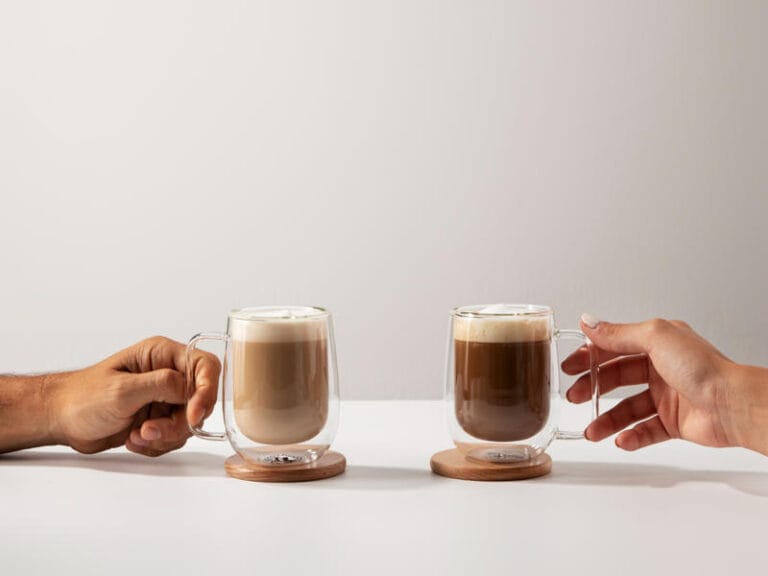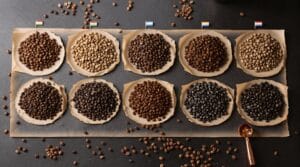White mocha and mocha differ in five key ways! Mocha uses dark chocolate with cocoa solids for bold, bitter-sweet coffee flavor, while white mocha swaps in cocoa butter and milk for creamy, vanilla-like sweetness. Ingredients shift between dark chocolate’s earthy depth and white chocolate’s sugary smoothness. White mocha tastes sweeter (like dessert) and lacks coffee’s sharp bite, while mocha balances bitter richness. Textures? Smooth silk vs. frothy grit. Crack open the next section to see which drink steals the spotlight!
Chocolate Variations: Dark vs. White
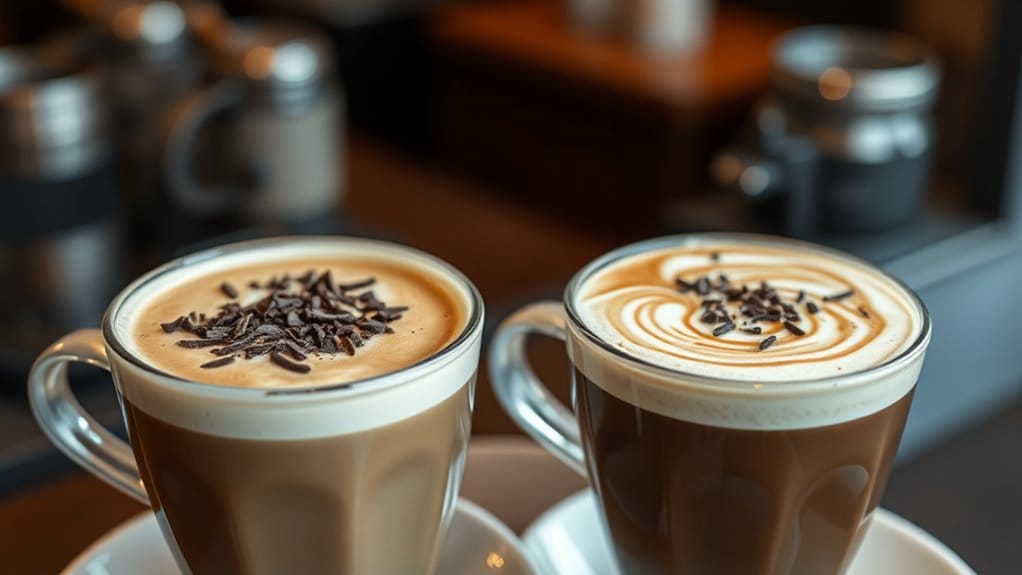
While both dark and white chocolate start with cocoa beans, they couldn’t be more different in taste, look, and ingredients.
Dark chocolate packs cocoa solids, cocoa butter, and sugar, giving a bold, bitter-sweet flavor—plus antioxidants!
Dark chocolate blends cocoa solids, butter, and sugar for robust bitter-sweet depth, amplified by antioxidant-rich complexity.
White chocolate skips the cocoa solids entirely, mixing cocoa butter, milk solids, and sugar for creamy sweetness and a pale, vanilla-like color. This dairy-rich concoction traces its origins to the 1930s by Nestlé, who developed it to utilize surplus cocoa butter from milk chocolate production. Dark’s firm, snap-friendly texture contrasts with white’s smooth, melt-in-your-mouth vibe.
This split shapes the white mocha vs mocha showdown: regular mocha uses dark chocolate for a rich, coffee-chocolate kick, while white mocha trades intensity for sugary, velvety bliss.
The difference between mocha and white mocha? Imagine biting into a dark chocolate bar versus licking a cupcake frosting—both delicious, but one’s for rebels, the other for sweet-toothed adventurers!
Flavor Profiles Compared
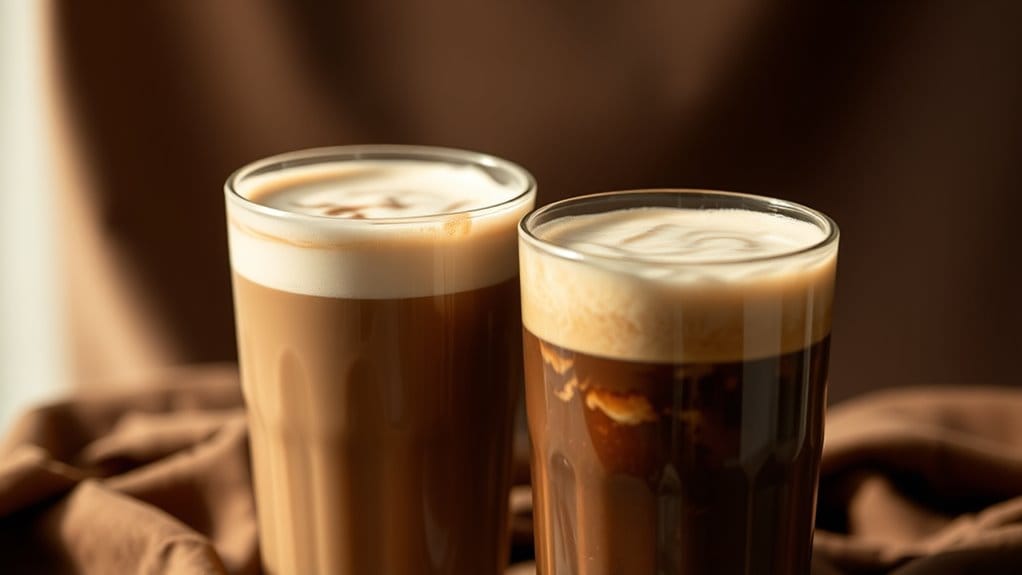
Just as dark and white chocolate clash in ingredients, their coffee versions spar in flavor.
A traditional mocha bursts with bold chocolate-coffee intensity, blending espresso’s bitterness with dark or milk chocolate’s rich depth. Its sharpness suits those craving a punchy, complex sip.
White mochas, though, swap cocoa solids for creamy white chocolate, turning the drink into a sweeter, smoother experience. The coffee flavor mellows here, letting the buttery sweetness take center stage, like a dessert in a cup! This divergence arises from white chocolate’s absence of cocoa solids, which removes bitter undertones and amps up creamy sweetness.
White mochas coat the tongue with velvety richness, while regular mochas keep things earthy and robust. Some love mochas for their grown-up edge; others pick white mochas to dodge bitterness entirely.
Choose one for a cozy, bold fix, the other for sugary, latte-like escapism.
Key Ingredients Breakdown
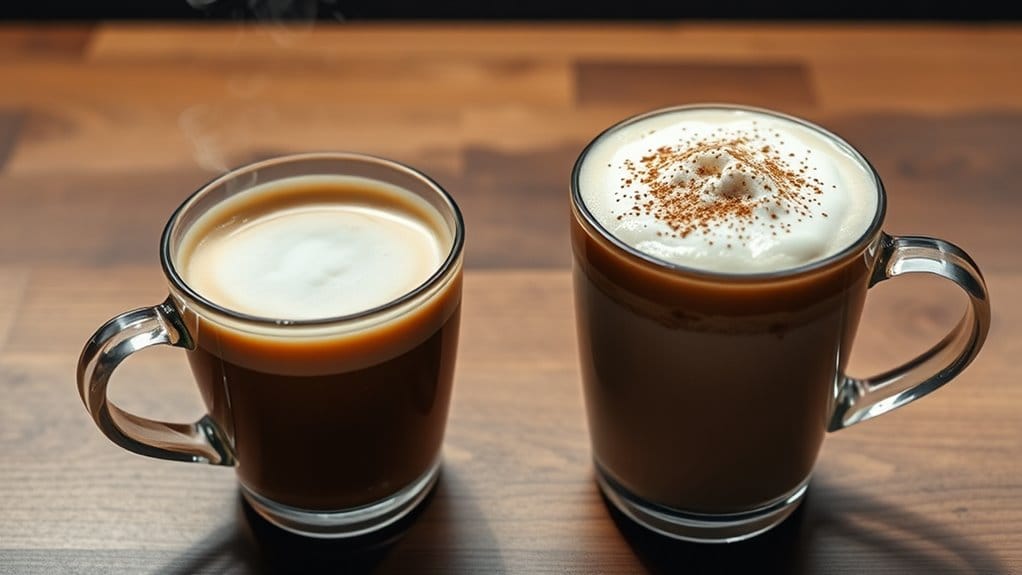
When you peek into a white mocha and its darker sibling, their ingredient lists spill the beans—both depend on espresso’s bold kick, but their chocolatey twists tell the full story.
- Chocolate Drama: White mocha stars cocoa butter-rich white chocolate (no cocoa solids!), delivering vanilla-laced sweetness, while mocha uses cocoa-packed dark/milk chocolate for deeper, bittersweet vibes.
- Milk Mavericks: Both blend espresso with steamed milk (cow’s, oat’s, almond’s—pick your fighter) to soften bitterness, but white mocha’s creaminess cranks indulgence up a notch.
- Sweet Secrets: White mocha often sneaks syrups or vanilla into its sugary script, while classic mocha leans on melted chocolate bars or syrup, no vanilla spywork required.
Hot take: White chocolate’s a rebel—it skips cocoa solids, sparking debates. Thanks to beans sourced from The Cocoa Belt—think Côte d’Ivoire to Ecuador—your mocha’s roots stretch halfway across the globe. Yet both drinks let you tweak milk, strength, or toppings like whipped cream confetti.
Sweetness Levels: Mocha vs. White Mocha
What sets apart a mocha from its paler cousin, the white mocha? The answer is sweetness, a big, sugary difference that changes everything.
A white mocha, made with velvety white chocolate syrup, is like a dessert in a cup, packed with creamy, vanilla-like sweetness that can almost hide the coffee’s bite.
Regular mocha sticks with dark or milk chocolate, creating a bold, less sugary flavor, where espresso and bitter cocoa tango on your tongue.
Think of white mocha as the sweet-tooth champion; its higher sugar levels come from syrup, white chocolate, and sometimes vanilla add-ons.
Regular mocha? It’s for those who crave coffee’s kick without a sugar rush.
Both can be tweaked—more syrup, less syrup, boom!—so freedom’s yours. Choose white for indulgence, classic for balance. Or, hey, have both and let your taste buds vote!
Additionally, both drinks can be elevated by experimenting with different types of milk alternatives to complement the sweetness or bitterness of the chocolate.
Texture and Consistency Differences
Texture and consistency turn each sip into a playground for your mouth—white mocha glides in like velvet, thanks to its smooth white chocolate blended with steamed milk, while regular mocha brings a bolder, denser vibe with dark chocolate that might even have a hint of grit.
- Cocoa butter vs. cocoa solids: White mocha’s cocoa butter melts smoothly, creating a creamy dream, while mocha’s cocoa solids add tiny, bold flecks that give it a touch of rugged charm.
- Milk harmony: Steamed milk teams up effortlessly with white chocolate for silky unity, but in mocha, milk fights cocoa solids, leaving behind a frothy-but-gritty battleground.
- Cool-down effect: White mocha stays thick and rich even as it chills, like a cozy blanket, but mocha thins out faster, like a melting snowman losing its edge.
Each sip’s texture tells a story—choose your adventure: creamy fairy tale or chocolatey thriller.
Frequently Asked Questions
Does White Mocha Contain Less Caffeine Than Traditional Mocha?
While caffeine origins fluctuate slightly, the decisive factor remains stealthily rooted in espresso shot count. White mocha’s caffeine hinges mostly on those shots; dark chocolate’s minimal contribution gives traditional mocha a marginal edge when espresso parity exists.
Can Both Mochas Be Made Dairy-Free Without Altering Flavor?
Regular mochas adapt better to dairy-free substitutions with plant-based milks and dark chocolate syrups, retaining near-original flavor. White mochas rely on dairy-based white chocolate, so dairy-free versions often alter taste due to ingredient limitations.
Are Mocha and White Mocha Syrup Shelf Lives the Same?
Mocha and white mocha syrups generally share comparable shelf lives (1–3 years unopened), though final duration depends on storage conditions, preservatives, and commercial formulations. Opened syrups degrade in a like manner unless exposed to contaminants or temperature extremes.
Which Pairs Better With Savory Snacks: Mocha or White Mocha?
Mocha pairs better with savory snacks due to dark chocolate’s bitter notes complementing salty flavors. White Mocha’s sweeter, creamier profile risks overpowering savory elements, making it less ideal for bold, salty contrasts. Choose based on desired flavor balance.
Do Mocha Variants Differ in Calorie Count Despite Similar Ingredients?
Mocha variants exhibit calorie differences despite overlapping ingredients. White mocha’s sugar-heavy chocolate syrup often increases caloric content versus dark chocolate-based mocha, with further variations emerging from milk choices, whipped cream, or other customizations.
References
- https://baradachocolate.com/white-chocolate-vs-dark-chocolate/
- https://lifeboostcoffee.com/blogs/lifeboost/uncovering-the-difference-between-mocha-and-white-mocha
- https://rawmio.com/blogs/news/white-vs-dark-chocolate-which-one-reigns-supreme
- https://foragersofhappiness.com/white-mocha-vs-mocha-what-is-the-difference/
- https://us.venchi.com/blog/different-chocolate-types-dark-vs-milk-vs-white-chocolate
- https://www.whitakerschocolates.com/blogs/blog/what-is-a-white-mocha-coffee
- https://foragersofhappiness.com/what-does-mocha-taste-like-plus-how-to-make-them/
- https://midwestniceblog.com/white-chocolate-mocha/

